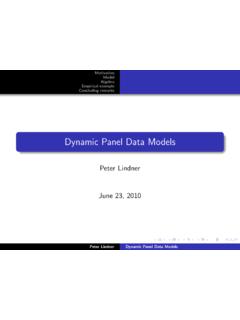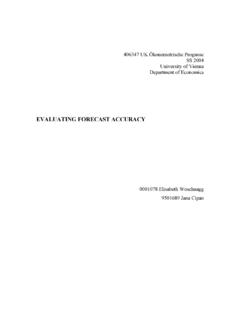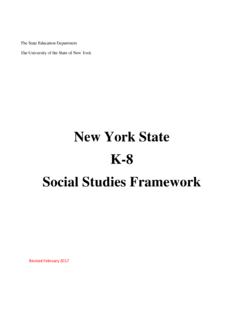Transcription of Introduction to Macroeconomics Lecture Notes
1 Introduction to Macroeconomics Lecture Notes Robert M. Kunst March 2006. 1 Macroeconomics Macroeconomics (Greek makro = big') describes and explains economic processes that concern aggregates. An aggregate is a multitude of economic subjects that share some common features. By contrast, microeconomics treats economic processes that concern individuals. Example: The decision of a firm to purchase a new o ce chair from com- pany X is not a macroeconomic problem. The reaction of Austrian house- holds to an increased rate of capital taxation is a macroeconomic problem. Why Macroeconomics and not only microeconomics? The whole is more complex than the sum of independent parts. It is not possible to de- scribe an economy by forming models for all firms and persons and all their cross-e ects.
2 Macroeconomics investigates aggregate behavior by imposing simplifying assumptions ( assume there are many identical firms that pro- duce the same good ) but without abstracting from the essential features. These assumptions are used in order to build macroeconomic models. Typi- cally, such models have three aspects: the story', the mathematical model , and a graphical representation. Macroeconomics is non-experimental': like, , history, macro - economics cannot conduct controlled scientific experiments (people would complain about such experiments, and with a good reason) and focuses on pure observation. Because historical episodes allow diverse interpretations, many conclusions of Macroeconomics are not coercive.
3 Classical motivation of Macroeconomics : politicians should be ad- vised how to control the economy, such that specified targets can be met optimally. policy targets: traditionally, the magical pentagon' of good economic growth, stable prices, full employment, external equilibrium, just distribution 1. of income; according to the EMU criteria, focus on inflation (around 2%), public debt, and a balanced budget; according to Blanchard, focus on low unemployment (around 5%), good economic growth, and inflation (0 3%). In all specifications, aim is meeting several conflicting targets simultaneously. Examples for further typical questions to Macroeconomics : what causes business cycles (episodes of stronger and weaker economic growth)?
4 Can an increase in the monetary supply by the central bank cause real e ects? what is responsible for long-run economic growth? should the exchange rate of a currency be kept at a fixed level? can one decrease unemployment, if one accepts an increase in inflation? A survey of world economics: three large economic blocks (Eu- rope, USA+Canada, Japan+Far East) with di erent problems, the remain- der mostly developing countries. 1. USA: good growth, low inflation, tolerable unemployment rate, per- sistent external deficit, increasing income inequality. 2. EU: moderate growth, low inflation, in some countries high unem- ployment, inconspicuous external balance (total EU active, in Austria recently turned active), for some countries large public debt, currently important unification process, convergence and heterogeneity of indi- vidual countries.
5 Richest' EU countries Luxembourg, Denmark, then mid-field' with Austria, IRL, B, NL, UK, D, F, FIN, I, S; slightly be- low E, GR, SLO, P. Last come most new' (2004 accession) countries (from Malta down to Latvia). Very rich' non-EU countries Norway, Iceland, and Switzerland. 3. Japan: recently weak growth, large external surplus, deflationary ten- dencies. 2. 2 System of National Accounts Basic idea (not the definition): Summary of all economic activities within a country's territory and within a given time range ( , a year or quarter). yields the gross domestic product (GDP). The value of all goods and ser- vices is determined at market prices (final prices, purchasers' prices). System for compilation of data and bookkeeping of all positions is called the System of National Accounts (SNA).
6 In Europe, compilation of the SNA conforms to the ESA (European System of Accounts) standard. economic activity is mainly measured by transactions. Phrases from text books: diversification of labor (not complete self-subsistence) causes transactions, exchange of money for goods or services, exchange of an asset or liability for a di erent asset or liability, etc. The transactions take place on markets. Money makes transactions easier than direct exchange of goods for goods, which may require double coincidence' (hungry tailor meets freezing baker). Purpose of money: apart from payment and storage of value primarily unit of measurement (numeraire). In economic text books, usually dollar ($), monetary unit (MU), or euro.
7 Gross: many activities serve to repair or replace worn or damaged ma- chines and objects ( depreciation'), therefore it is not the total GDP that contributes to the accumulation of aggregate wealth. In the SNA, gross'. usually means inclusive of depreciation', net' often contains taxes, though no depreciation. Consumption of fixed capital (in economics, depreciation) of SNA is the estimated wear and tear of produced means of production (this depreciation'. should not be confused with positions in tax declarations or with changes in the currency exchange rate). 3. Capital stock is the stock of fixed capital (machines, buildings, ..) in enterprises and in the general government sector. This must be distinguished carefully from the informal usage of the word capital' as money, liquid wealth'.
8 By definition, capital contains all produced means of production. The separation of capital such as machinery from intermediate consumption such as raw materials can be di cult. economic activities: only market activities can be fully accounted for. Therefore, private exchange and domestic services pass by unnoticed. By de- finition, however, legitimacy of a transaction should not play a role. There- fore, the shadow economy (moonlighting) and illegal drug production are part of the GDP, but such activities are di cult to measure. A consequence of this measurement problem is an exaggerated wedge between developing countries and OECD countries (with the per capita GDP of Angola you can- not survive in Austria).
9 Interest focuses on transactions bilateral (requited). transactions (purchase etc.) and unilateral (unrequited) transactions (trans- fers) while value changes of existing objects are not accounted fully. value added: definition of GDP as the sum of values added in the produc- tion process (ore metal screw motor part video recorder) avoids multiple counts. Problems in the valuation of public services. market prices: in principle, all goods and services are valued at market prices, that is, inclusive of all taxes. If data is collected at the net value (without taxes), taxes must be added. economic agents: Resident institutional units' are classified with regard to their distinctive characteristics. Types of institutional units are: pri- vate households, general government, financial and non-financial corpora- tions (comprises most so called firms or enterprises), non-profit institutions serving households.
10 Foreign (non-resident) units are summarized as the rest 4. of the world', provided there are transactions with resident units. The same person can be part of a private household and of an enterprise (rents out an apartment, or even only uses his/her own condo but is assumed to rent it out to him/herself). resident is an institutional unit that is situated on a country's territory. Citizenship is not the criterion for residence. However, foreign students or short-term foreign workers are not viewed as resident. private households: produce and invest relatively little, consume, obtain wage and profit income from corporations and from the government. As self-employed persons, they obtain mixed income', though the separation of households from corporations is occasionally di cult.










